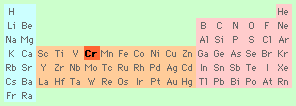 Background
information
Background
information Background
information
Background
informationChromium (Cr) is in the first series of transition metals.
The main artificial sources of chromium in the environment are
Tanning is the process of changing skins and hides into leather. The skins are treated in various ways to remove hair and flesh and then treated with chromium(III) sulphate (Cr2(SO4)3) under basic conditions. This results in the cross-linking of the collagen molecules in the skin causing an increase in strength (toughness) and resistance to bacterial attack. The resulting leather is then treated with various waxes to render it water-proof.
Chromium plating is usually carried out by dipping the object to be plated in a bath containing a mixture of sodium dichromate (Na2Cr2O7) and sulphuric acid (H2SO4). Waste solutions contain a mixture of the dichromate(VI), Cr2O72-, chromate(VI), CrO42-, and chromium(III) ions, Cr3+.
Chromate(VI), CrO42-, and dichromate(VI) ions, Cr2O72-, are readily reduced to chromium(III), Cr3+, by organic matter in the environment.
In aqueous solution, the chromate(VI) ion is yellow, the dichromate(VI) ion is orange and the chromium(III) ion is green.
Chromates act as irritant to the eye, nose and throat.
Prolonged exposure can cause liver and kidney damage and possible carcinogenic effects.
Low concentrations of chromate(VI) ions can cause dermatitis.
Chromium(III) shows little toxicity.